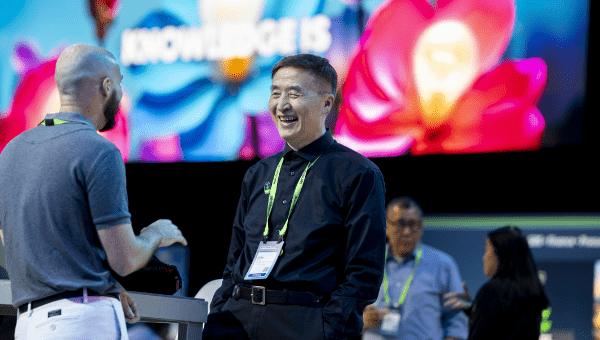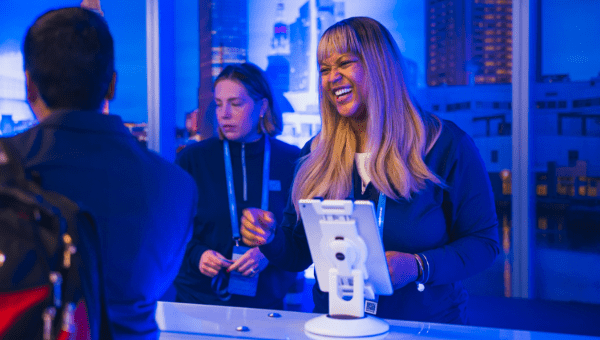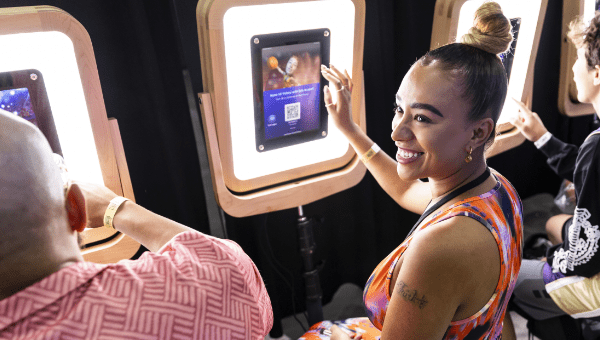Imagine transforming your keynote stage into an immersive environment, or even revolutionizing the facade of a centuries-old mission into a canvas of lights and colors. Both are possible with projection mapping — using multi-dimensional and multi-shaped surfaces to showcase video, graphics, and all manner of imagery.
Let’s explore what this exciting technology can do for your event content and the attendee experience.
What is projection mapping?
This sophisticated visual technique goes beyond traditional screen projection by broadcasting images onto larger surfaces, effectively turning them into unexpected digital canvases.
Technically there are two types, each defined by the projection surface itself:
- Projection mapping: Content that’s projected onto three-dimensional objects or irregular surfaces, creating the illusion of movement and transformation across those complex shapes and angles.
- Projection masking: Images or videos cast onto flat surfaces of unique shapes with unconventional borders that go beyond standard, rectangular screens.
How does it apply to live events?
Projection mapping is more than just a visual trick. It also enhances attendee engagement by providing that coveted “wow” factor they’ll remember long after the event ends.
To nail this visual upgrade and achieve the best results, it’s important to take note of some technical variables:
- Surfaces: Whether flat or multi-dimensional, the key to choosing the correct one is to make sure nothing about the size or shape will skew the image.
- Lighting: Be strategic when calibrating and placing lights so the images being projected aren’t washed out.
- Projectors: That same note applies to where you place the projectors to ensure the image falls exactly where you want, and it isn’t obstructed.
- Audio: Adding in sounds and music — especially via high-quality systems — can enhance the feeling of seeing the projections come to life.
- Content – Considering content is especially important with projection mapping. Pre-rendered and live content should be based on both the projected surfaces and variables mentioned above.
Projection Mapping Showcase
We apply this technique in a variety of ways, at all sorts of events, and have learned a few things along the way:

Groceryshop 2024: Elevating thematic concepts
For the keynote presentations at this global CPG conference, we used a predetermined theme to create a captivating visual backdrop across a series of 17 circles. It amplified both the show’s branding and speakers’ presentations.
Insider insight: Have detailed pre-show discussions and Q/A sessions that touch on budget, concept, content, and execution.

NADA: Pushing boundaries
This automotive trade show project showed how this can be used in expo hall settings. We created a dynamic display of a speeding car on a wall as attendee traffic flowed around it.
Insider insight: Be prepared to adapt to on-site variables, like people moving around your projection or A/C and ventilation that could cause your surface to move unexpectedly.

Visit San Antonio: Outdoor spectacle
For a city-wide activation and celebration we projected onto a centuries-old Spanish-colonial mission. This presented a unique challenge that combined casting onto a multi-dimensional surface with planning for outdoor environmental elements.
Insider Insight: When planning outdoor events, consider factors like ambient light, weather conditions, and the location of power sources.
How to make the magic happen
Both the skill and technology that go into projection mapping are impressive, but they’re not out of reach. Especially since AV tech is already a line item in your budget.
Here are a couple ways to incorporate this approach while also saving on costs:
- Repurpose existing digital assets and graphics by simply adapting them for projection.
- Focus on using projection mapping to create a single high impact “wow” moment rather than using the tech continuously throughout the event or program.
How cool would it be to illuminate your next event with the power of projection mapping?
Let’s map it out!
Want more insights about creating dynamic event moments?



